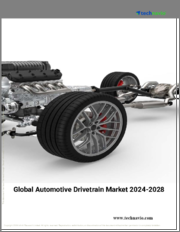
|
시장보고서
상품코드
1569450
자동차 드라이브트레인 시장 규모, 점유율, 성장 분석 : 차량 유형별, 구동 유형별, 전기자동차 유형별, 지역별 - 산업 예측(2024-2031년)Automotive Drivetrain Market Size, Share, Growth Analysis, By Vehicle Type, By Drive Type, By Electric Vehicle Type, By Region - Industry Forecast 2024-2031 |
||||||
자동차 드라이브트레인 세계 시장 규모는 2022년 2,192억 5,000만 달러로 2023년 2,328억 4,000만 달러에서 2031년 3,767억 6,000만 달러로 예측 기간(2024-2031) 동안 연평균 6.20% 성장할 것으로 예상됩니다.
자동차 드라이브트레인 시장은 운전 경험, 편안함, 안전성을 향상시키는 자동차에 대한 소비자 수요 증가에 힘입어 큰 폭으로 성장하고 있습니다. 휠, 구동축, U자형 조인트, CV 조인트 등의 부품이 포함된 이 중요한 시스템은 구동륜에 동력을 전달하는 데 중요한 역할을 하며, 궁극적으로 엔진 성능과 연비 효율에 영향을 미칩니다. 전기자동차(EV)의 인기 급상승은 특히 강력한 원동력이며, 이러한 자동차는 첨단 드라이브트레인 시스템을 필요로 하기 때문에 규제, 보조금, 세제 혜택, 세액 공제 등의 정부 지원책이 이 분야의 생산과 판매를 더욱 촉진하고 있습니다. 또한, 연비와 성능을 향상시키기 위해 설계된 경량 구동축의 개발 추세도 시장 전망에 긍정적인 영향을 미치고 있습니다. 이러한 역학에 비추어 볼 때, 미국 자동차 드라이브트레인 시장은 지속가능한 성장을 이룰 수 있는 위치에 있으며, 향후 예측 기간 동안 연평균 성장률(CAGR)이 안정적일 것으로 예상됩니다. 이는 지속가능성과 효율성을 우선시하는 광범위한 자동차 트렌드와 일치하며, 자동차 드라이브트레인 시장을 전체 자동차 산업의 발전에 있어 매우 중요한 역할을 하고 있습니다.
목차
소개
- 조사 목적
- 정의
- 시장 범위
조사 방법
- 정보 조달
- 2차 데이터 소스와 1차 데이터 소스
- 시장 규모 예측
- 시장 상정과 제한
주요 요약
- 시장 개요 전망
- 공급 수요 동향 분석
- 부문별 기회 분석
시장 역학과 전망
- 시장 역학
- 성장 촉진요인
- 기회
- 성장 억제요인
- 과제
- Porters 분석
주요 시장 인사이트
- 주요 성공요인
- 경쟁 정도
- 주요 투자 기회
- 시장 생태계
- 기술 분석
- 밸류체인 분석
- 규제 상황
- 가격 분석
자동차 드라이브트레인 시장 : 차종별
- 시장 개요
- 승용차
- 소형 상용차
- 대형 상용차
- 트럭
- 버스
자동차 드라이브트레인 시장 : 구동 유형별
- 시장 개요
- 전륜구동
- 후륜구동
- 총륜구동
자동차 드라이브트레인 시장 : 전기자동차 유형별
- 시장 개요
- 배터리 전기자동차
- 플러그인 하이브리드 전기자동차
- 하이브리드 전기자동차
자동차 드라이브트레인 시장 규모 : 지역별
- 시장 개요
- 북미
- 미국
- 캐나다
- 유럽
- 독일
- 스페인
- 프랑스
- 영국
- 이탈리아
- 기타 유럽
- 아시아태평양
- 중국
- 인도
- 일본
- 한국
- 기타 아시아태평양
- 라틴아메리카
- 브라질
- 기타 라틴아메리카
- 중동 및 아프리카(MEA)
- GCC 국가
- 남아프리카공화국
- 기타 중동 및 아프리카
경쟁 상황
- 상위 5개사의 비교
- 주요 기업의 시장 포지셔닝(2023년)
- 주요 시장 기업이 채용한 전략
- 시장의 최근 활동
- 주요 기업의 시장 점유율(2023년)
주요 기업 개요
- Aisin Seiki Co., Ltd.
- American Axle & Manufacturing, Inc.
- BorgWarner Inc.
- Melrose Industries
- ZF Friedrichshafen AG
- Magna International Inc.
- Dana Holding Corporation
- JTEKT Corporation
- Schaeffler Group
- Cummins Inc
- Hyundai WIA Corporation
- Valeo SA
- Linamar Corporation
- Hitachi
- Eaton Corporation
- NTN Corporation
Global Automotive Drivetrain Market size was valued at USD 219.25 billion in 2022 and is poised to grow from USD 232.84 billion in 2023 to USD 376.76 billion by 2031, growing at a CAGR of 6.20% during the forecast period (2024-2031).
The automotive drivetrain market is witnessing significant growth, fueled by rising consumer demand for vehicles that enhance driving experiences, comfort, and safety. This critical system, encompassing components such as wheels, drive shafts, U-joints, and CV joints, plays a vital role in power transmission to the driving wheels, ultimately influencing engine performance and fuel efficiency. The surge in electric vehicle (EV) popularity is a particularly strong driver, as these vehicles necessitate advanced drivetrain systems, and supportive government measures-such as regulations, subsidies, tax incentives, and credits-are further encouraging production and sales in this sector. Additionally, the trend towards lightweight driveshafts, designed for improved fuel efficiency and performance, is contributing positively to the market outlook. Given these dynamics, the US automotive drivetrain market is positioned for sustainable growth, with projections indicating a steady compound annual growth rate (CAGR) for the upcoming forecast period. This aligns with broader automotive trends that prioritize sustainability and efficiency, making the automotive drivetrain market pivotal to the overall evolution of the automotive industry.
Top-down and bottom-up approaches were used to estimate and validate the size of the global automotive drivetrain market and to estimate the size of various other dependent submarkets. The research methodology used to estimate the market size includes the following details: The key players in the market were identified through secondary research, and their market shares in the respective regions were determined through primary and secondary research. This entire procedure includes the study of the annual and financial reports of the top market players and extensive interviews for key insights from industry leaders such as CEOs, VPs, directors, and marketing executives. All percentage shares split, and breakdowns were determined using secondary sources and verified through Primary sources. All possible parameters that affect the markets covered in this research study have been accounted for, viewed in extensive detail, verified through primary research, and analyzed to get the final quantitative and qualitative data.
global automotive drivetrain Market Segmental Analysis
Global Automotive Drivetrain Market is segmented by Vehicle Type, Drive Type, Electric Vehicle Type, and Region. Based on Vehicle Type, the market is segmented into Passenger Car, Light Commercial Vehicles, Heavy Commercial Vehicles (Trucks, Buses). Based on Drive Type, the market is segmented into Front Wheel Drive, Rear Wheel Drive, All-Wheel Drive. Based on Electric Vehicle Type, the market is segmented into Battery Electric Vehicles, Plug-In Hybrid Electric Vehicles, Hybrid Electric Vehicles. Based on region, the market is segmented into North America, Europe, Asia Pacific, Latin America and Middle East & Africa.
Driver of the global automotive drivetrain Market
The growing consumer demand for superior driving experiences, enhanced comfort, and heightened safety features is a pivotal market driver for the global automotive drivetrain market. As automotive buyers increasingly prioritize vehicles that deliver exceptional performance, optimal handling, and greater fuel efficiency, automakers are compelled to innovate and integrate advanced drivetrain technologies. This trend is further augmented by the rising awareness of environmental concerns and regulatory pressures for fuel-efficient solutions, prompting manufacturers to invest in the development of sophisticated drivetrain systems, such as electric and hybrid drivetrains. Consequently, this evolving consumer preference significantly contributes to the expansion of the automotive drivetrain market on a global scale.
Restraints in the global automotive drivetrain Market
The global automotive drivetrain market faces significant restraints due to the high costs associated with the development of advanced drivetrain technologies and components. These expenditures encompass extensive research, engineering, and rigorous testing, which can be prohibitively expensive for smaller manufacturers and start-ups. As a result, these financial barriers restrict their ability to enter the market effectively or compete with established industry players who have more substantial resources and experience. This imbalance not only stifles innovation but also limits diversity in the market, as new entrants struggle to bring alternative solutions and technologies to consumers, potentially hindering overall market growth.
Market Trends of the global automotive drivetrain Market
The global automotive drivetrain market is experiencing a pronounced shift towards electrification, driven by escalating environmental concerns and stringent emission regulations. This trend signifies a pivotal transition from traditional internal combustion engines to electric vehicles (EVs) and hybrid electric vehicles (HEVs). Automakers are prioritizing the development of advanced electric drivetrain systems, emphasizing innovations in battery technology, electric motors, power electronics, and regenerative braking systems. These advancements are aimed at enhancing vehicle efficiency and extending driving range, positioning EVs and HEVs as viable alternatives in the automotive landscape. This electrification trend is reshaping market dynamics, fostering investments in sustainable technologies and infrastructure.
Table of Contents
Introduction
- Objectives of the Study
- Definitions
- Market Scope
Research Methodology
- Information Procurement
- Secondary & Primary Data Sources
- Market Size Estimation
- Market Assumptions & Limitations
Executive Summary
- Market Overview Outlook
- Supply Demand Trend Analysis
- Segmental Opportunity Analysis
Market Dynamics & Outlook
- Market Dynamics
- Drivers
- Opportunities
- Restraints
- Challenges
- Porters Analysis
- Competitive rivalry
- Threat of Substitute Products
- Bargaining Power of Buyers
- Threat of New Entrants
- Bargaining Power of Suppliers
Key Market Insights
- Key Success Factor
- Degree of Competition
- Top Investment Pockets
- Ecosystem of the Market
- Technology Analysis
- Value Chain Analysis
- Regulatory Landscape
- Pricing Analysis
Automotive Drivetrain Market, By Vehicle Type
- Market Overview
- Passenger Car
- Light Commercial Vehicles
- Heavy Commercial Vehicles
- Trucks
- Buses
Automotive Drivetrain Market, By Drive Type
- Market Overview
- Front Wheel Drive
- Rear Wheel Drive
- All-Wheel Drive
Automotive Drivetrain Market, By Electric Vehicle Type
- Market Overview
- Battery Electric Vehicles
- Plug-In Hybrid Electric Vehicles
- Hybrid Electric Vehicles
Automotive Drivetrain Market Size by Region
- Market Overview
- North America
- USA
- Canada
- Europe
- Germany
- Spain
- France
- UK
- Italy
- Rest of Europe
- Asia Pacific
- China
- India
- Japan
- South Korea
- Rest of Asia-Pacific
- Latin America
- Brazil
- Rest of Latin America
- Middle East & Africa (MEA)
- GCC Countries
- South Africa
- Rest of MEA
Competitive Landscape
- Top 5 Player Comparison
- Market Positioning of Key Players, 2023
- Strategies Adopted by Key Market Players
- Recent Activities in the Market
- Key Companies Market Share (%), 2023
Key Company Profiles
- Aisin Seiki Co., Ltd.
- Company Overview
- Business Segment Overview
- Financial Updates
- Key Developments
- American Axle & Manufacturing, Inc.
- Company Overview
- Business Segment Overview
- Financial Updates
- Key Developments
- BorgWarner Inc.
- Company Overview
- Business Segment Overview
- Financial Updates
- Key Developments
- Melrose Industries
- Company Overview
- Business Segment Overview
- Financial Updates
- Key Developments
- ZF Friedrichshafen AG
- Company Overview
- Business Segment Overview
- Financial Updates
- Key Developments
- Magna International Inc.
- Company Overview
- Business Segment Overview
- Financial Updates
- Key Developments
- Dana Holding Corporation
- Company Overview
- Business Segment Overview
- Financial Updates
- Key Developments
- JTEKT Corporation
- Company Overview
- Business Segment Overview
- Financial Updates
- Key Developments
- Schaeffler Group
- Company Overview
- Business Segment Overview
- Financial Updates
- Key Developments
- Cummins Inc
- Company Overview
- Business Segment Overview
- Financial Updates
- Key Developments
- Hyundai WIA Corporation
- Company Overview
- Business Segment Overview
- Financial Updates
- Key Developments
- Valeo SA
- Company Overview
- Business Segment Overview
- Financial Updates
- Key Developments
- Linamar Corporation
- Company Overview
- Business Segment Overview
- Financial Updates
- Key Developments
- Hitachi
- Company Overview
- Business Segment Overview
- Financial Updates
- Key Developments
- Eaton Corporation
- Company Overview
- Business Segment Overview
- Financial Updates
- Key Developments
- NTN Corporation
- Company Overview
- Business Segment Overview
- Financial Updates
- Key Developments



















